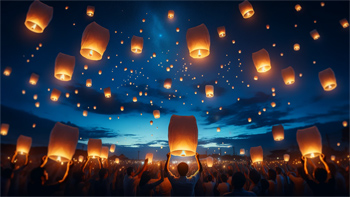Vesak, also known as Buddha Purnima and Buddha Day, is a significant festival in Buddhism, celebrating the birth, enlightenment, and death (Parinirvana) of Gautama Buddha. This day holds immense spiritual importance in various Buddhist communities around the world. Vesak is observed on the full moon day of the Vaisakha month in the Buddhist and Hindu calendars, which typically falls in April or May in the Gregorian calendar. This article explores the history, traditions, and cultural significance of Vesak, providing insights into how this auspicious day is celebrated across different countries.
Historical Background of Vesak
The origins of Vesak date back to ancient times, commemorating the life and teachings of Siddhartha Gautama, who later became known as the Buddha. According to Buddhist tradition, all three significant events in the life of Buddha - his birth, enlightenment, and death - occurred on the same day of the year, Vesak. The day is marked with great reverence and serves as a reminder of Buddha's contribution to humanity's spiritual awakening. The historical significance of Vesak is deeply rooted in Buddhist scriptures, which narrate the extraordinary events surrounding the Buddha's birth in Lumbini, his attainment of enlightenment under the Bodhi tree in Bodh Gaya, and his final passing into Parinirvana in Kushinagar. These events are not just historical milestones but also spiritual symbols of the journey towards enlightenment, reflecting the Buddha's teachings on the nature of suffering, the path to its cessation, and the realization of Nirvana. Over the centuries, the observance of Vesak has evolved, incorporating various cultural elements, but the core message remains the same - a celebration of the Buddha's universal teachings of compassion, wisdom, and peace. In many Buddhist traditions, Vesak is also a time for reflecting on the Buddha's teachings and their relevance to contemporary life, encouraging practitioners to follow the path of ethical living, meditation, and wisdom. The celebration of Vesak thus bridges the historical life of the Buddha with the timeless aspects of his teachings, making it a day of profound spiritual significance and a beacon of hope and enlightenment in an ever-changing world.
Celebrations Around the World
Vesak is celebrated with great enthusiasm and varying customs in different parts of the world. In countries like Sri Lanka, India, Nepal, Tibet, Bangladesh, and various Southeast Asian countries, it's a day of joy and reflection. Activities include prayer meetings, religious discussions, recitation of Buddhist scriptures, and the display of Buddhist relics. The celebration of Vesak also involves acts of charity like providing food and help to the needy, donations, and animal liberation.
Symbolic Rituals and Practices
Various symbolic rituals are associated with Vesak, reflecting the teachings and life of Buddha. These include the Bathing of the Buddha ceremony, where water is poured over the shoulders of the Buddha statue, symbolizing a fresh start and the purification of one's mind. Devotees also engage in meditation and observe the Eight Precepts, a more stringent practice than the usual Five Precepts followed by lay Buddhists, to cultivate their spiritual discipline.
Decorations and Lanterns
One of the most visible aspects of Vesak celebrations is the vibrant decorations and lanterns that adorn temples, homes, and streets. In many countries, lantern-making competitions are held, adding a festive mood to the occasion. These lanterns and decorations symbolize the light of Buddha's teachings that dispel the darkness of ignorance.
Vesak and Vegetarianism
During Vesak, many Buddhists adopt a vegetarian diet as a way to honor life in all its forms, in line with the Buddhist precept of non-harming (Ahimsa). This practice symbolizes respect for life and the interconnection of all beings, reflecting Buddha's teachings on compassion and kindness.
Community and Charity
Community service and charity are significant aspects of Vesak. Buddhists around the world engage in various charitable deeds such as donating to the poor, organizing blood donation camps, and providing aid to the sick and elderly. This altruistic aspect of Vesak underscores the Buddhist values of compassion and generosity.
Global Recognition of Vesak
In 1999, the United Nations recognized Vesak as an international day of observance, acknowledging its universal appeal and the profound impact of Buddha's teachings on humanity. This recognition has led to wider global awareness and participation in Vesak celebrations, transcending cultural and geographical boundaries.
Impact on Spiritual Life
Vesak is not just a day of celebration but also a time for introspection and spiritual renewal for Buddhists. It offers a chance to recommit to the teachings of Buddha, practicing mindfulness, loving-kindness, and a deeper understanding of life's impermanent nature. The day serves as a powerful reminder of the potential for enlightenment that lies within every individual.
Vesak in the Modern World
As the world becomes increasingly interconnected, Vesak provides an opportunity for people from diverse backgrounds to learn about Buddhist teachings. It has evolved to become a cultural event that fosters understanding and peace, encouraging people to adopt values of tolerance, respect, and empathy in their daily lives.
In essence, Vesak is a profound celebration of the Buddha and his teachings. It is a day that encapsulates the essence of Buddhism, highlighting the themes of compassion, peace, and spiritual awakening. Through its colorful rituals, community gatherings, and acts of kindness, Vesak continues to inspire millions around the globe, promoting values that are ever-relevant in our contemporary world.
